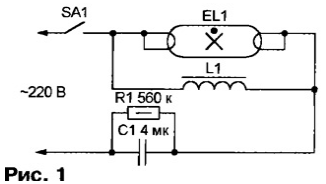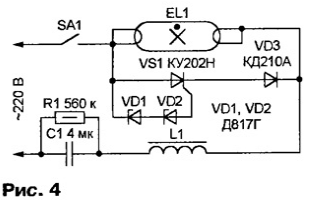
|
|
ENCYCLOPEDIA OF RADIO ELECTRONICS AND ELECTRICAL ENGINEERING About ways to start fluorescent lamps. Encyclopedia of radio electronics and electrical engineering
Encyclopedia of radio electronics and electrical engineering / Lighting Daylight fluorescent lamps (LDS) are not only economical, but also have a long service life, which, unfortunately, is rarely fully realized. The reason for this is the burnout of the filaments of the lamp or the premature loss of emission by its cathodes. A lot of advice has already been published on the "revitalization" of LDS, which are not suitable for use when switched on according to traditional schemes. Most of them come down to supplying the lamp with a constant current of increased, compared to the nominal, voltage. As a rule, this gives only a short-term effect, since direct current causes accelerated degradation of the lamp and very soon it fails completely. We talk about several schemes of lamps in which you can install LDS with burnt out filaments. Their common feature is that only alternating current flows through a burning lamp. S. REMENKO from Chisinau (Moldova) suggests recalling the forgotten method of igniting the LDS due to resonance in the oscillatory circuit formed by a choke connected in parallel with the lamp and a "ballast" capacitor. In the device, the scheme of which is shown in Fig. 1, the elements available in any standard luminaire were used: a capacitor with a capacity of 3,8 ... 4 μF and a choke 1UBI-40/220-VP-051U4 or similar.
While the LDS is off, the quality factor of the oscillating circuit L1C1 is relatively high, and when the switch SA1 is closed, the voltage across the inductor L1 exceeds the mains voltage, reaching a value sufficient for the occurrence of a gas discharge in the LDS EL1. A flashing lamp shunts the inductor, reducing the quality factor of the circuit. The voltage is reduced to what is necessary to maintain the discharge. In principle, the throttle is no longer needed after this and can be turned off. The test showed that both "short" (with a power of 15 ... 20 W) and "long" LDS with good cathode emission ignite reliably and burn steadily. If the emission is degraded, the LDS will have to be switched on in parallel, as shown in Fig. 2, two chokes (L1 and L3) connected in series of the above type. In series with the capacitor C1, a choke L2 is installed here. Since the inductance of a standard single-winding choke is too high for it, a two-winding choke 1UBE-40/220-VPP-010U4 is used, the windings of which are connected in parallel. Having previously closed the SA1 switch, the LDS is ignited by pressing the SB1 button. As soon as the lamp lights up, the button can be released. If an additional button is undesirable, the circuit of chokes L1 and L3 can be left permanently closed or provided for its short-term (for 0,1 ... .0,5 s) relay closure with a simple timer.
Instead of two standard chokes L1 and L3, you can install one home-made one on the magnetic circuit from the TCA-70 transformer. On each core of the magnetic circuit, 500 turns of wire PEV-2 0,51 are wound, and one of the two windings is made with taps every 50 turns. Having connected the windings in series, the desired inductance is selected experimentally by switching taps. Sometimes, in order to achieve reliable ignition of the LDS, the capacitance of the capacitor C1 has to be increased to 6 (for "short" lamps) and even up to 8 microfarads (for "long"). When using used standard chokes, it should be borne in mind that inter-turn short circuits are not uncommon in them. You can distinguish faulty from serviceable by strong heating during operation. The power consumed by the lamp on the LDS should be measured by dividing the amount of energy consumed by it over a sufficiently long interval of time (this value is determined by a conventional electric meter) by the duration of this interval. The voltmeter-ammeter method does not give the correct result due to a significant phase shift between current and voltage. M. BYKOVSKY from the city of Orel has developed an LDS starter device, in which the increased voltage necessary to ignite the lamp is obtained using a voltage multiplier rectifier. After the discharge occurs, the multiplier is turned off and the burning of the LDS is supported by an alternating current flowing through a conventional choke. The device, assembled according to the scheme shown in Fig. 3, tested with 20W to 80W LDS.
The types and ratings of the elements marked with asterisks in the diagram for LDS of various capacities are shown in the table.
After the switch SA1 is closed, no current flows through the inductor L1 and the relay K1 remains de-energized. Thanks to the normally closed contacts K1.1, the mains voltage is supplied to the rectifier with voltage multiplication (diodes VD2-VD5, capacitors C1, C2, C4, C5). As a result, a high (1..-1000 V) DC voltage sufficient for the occurrence of a gas discharge is applied to the EL1200 lamp. When the lamp EL1 lights up and current flows in its circuit, in the positive half-cycles of the voltage drop across the inductor L1, the capacitor C3 is charged through the diode VD1 and the resistor R1. After a few seconds (this exposure allows the LDS cathodes to heat up due to ion bombardment), the voltage across the capacitor will become sufficient to operate relay K1, the contacts of which will exclude the voltage multiplier from the LDS power supply circuit. Relay K1 - RES32 version RF4.519.021-00 with a winding resistance of 3500 Ohm and a trip current of 14 mA. You can also use another one with a trip current of not more than 30 mA and an allowable voltage between open contacts of at least 1500 V. When replacing a relay, you should select the value and power of resistor R1. Capacitor C3 - K50-24. It must be designed for a voltage of at least one and a half times the voltage of the operation of relay K1. A. DOVODILOV from Cherepovets also shares his method of igniting LDS. The classical scheme is taken as a basis, but in the proposed device (Fig. 4) the discharge in the lamp occurs due to the application of a voltage to it, almost equal to twice the amplitude of the network. As soon as the instantaneous value of the voltage between the electrodes of the off lamp EL1 exceeds (in the positive half-cycle) the total stabilization voltage of the zener diodes VD1 and VD2, the trinistor VS1 will be opened. As a result, the capacitor C1 through the trinistor, the diode VD3 and the inductor L1 will be charged to the peak value of the mains voltage (220-1,41-310 V). In the next negative half-cycle, the diode VD3 is closed, so the trinistor VS1 and the zener diodes VD1, VD2 do not participate in the work, the capacitor C1 does not recharge. Due to the remaining charge of the capacitor, the voltage between the electrodes of the LDS in this half-cycle reaches 620 V, which leads to the ignition of the lamp.
The voltage drop on the burning lamp (approximately 150 V) is no longer enough to open the zener diodes with a total stabilization voltage of 180 V, so the VS1 trinistor will no longer open. The current flowing through the LDS, as when turned on according to the classical scheme, is limited by the C1L1 circuit. Two Zener diodes D817G can be replaced by an arbitrary number of others, taking care that their total stabilization voltage is in the range of 180 ... 270 V. In extreme cases, a chain of series-connected zener diodes can be replaced by an ordinary resistor. However, its value will have to be selected in a wide range, because the turn-on current spread of even the same type of trinistors is very large. It is impossible to guarantee long-term stable operation of the device in this case. As a replacement for the KU202N trinistor, KU216A-KU216V, KU220A-KU220D, KU228Zh1, KU228I1 and others are suitable, designed for a direct current of at least 0,5 A and withstanding a forward voltage of more than 400 V in the closed state. Diode VD3 - any with a permissible reverse voltage not less than 700 V and direct current 0,5 A.
Machine for thinning flowers in gardens
02.05.2024 Advanced Infrared Microscope
02.05.2024 Air trap for insects
01.05.2024
▪ 60 GHz transceiver with built-in self-calibration ▪ Artificial intelligence will identify dangerous drivers ▪ Fats are burned in the evenings
▪ radio section of the website. Article selection ▪ Volyapyuk's article. Popular expression ▪ article car painter. Job description ▪ article What time is it? Focus secret. Focus Secret
Comments on the article: Guest It is possible and necessary to power on direct current so as not to spoil the eyesight of a 100 Hz morgue. And how it starts to "fall apart" to change polarity, about once every 2 days.
Home page | Library | Articles | Website map | Site Reviews www.diagram.com.ua |






 Arabic
Arabic Bengali
Bengali Chinese
Chinese English
English French
French German
German Hebrew
Hebrew Hindi
Hindi Italian
Italian Japanese
Japanese Korean
Korean Malay
Malay Polish
Polish Portuguese
Portuguese Spanish
Spanish Turkish
Turkish Ukrainian
Ukrainian Vietnamese
Vietnamese





 Leave your comment on this article:
Leave your comment on this article: